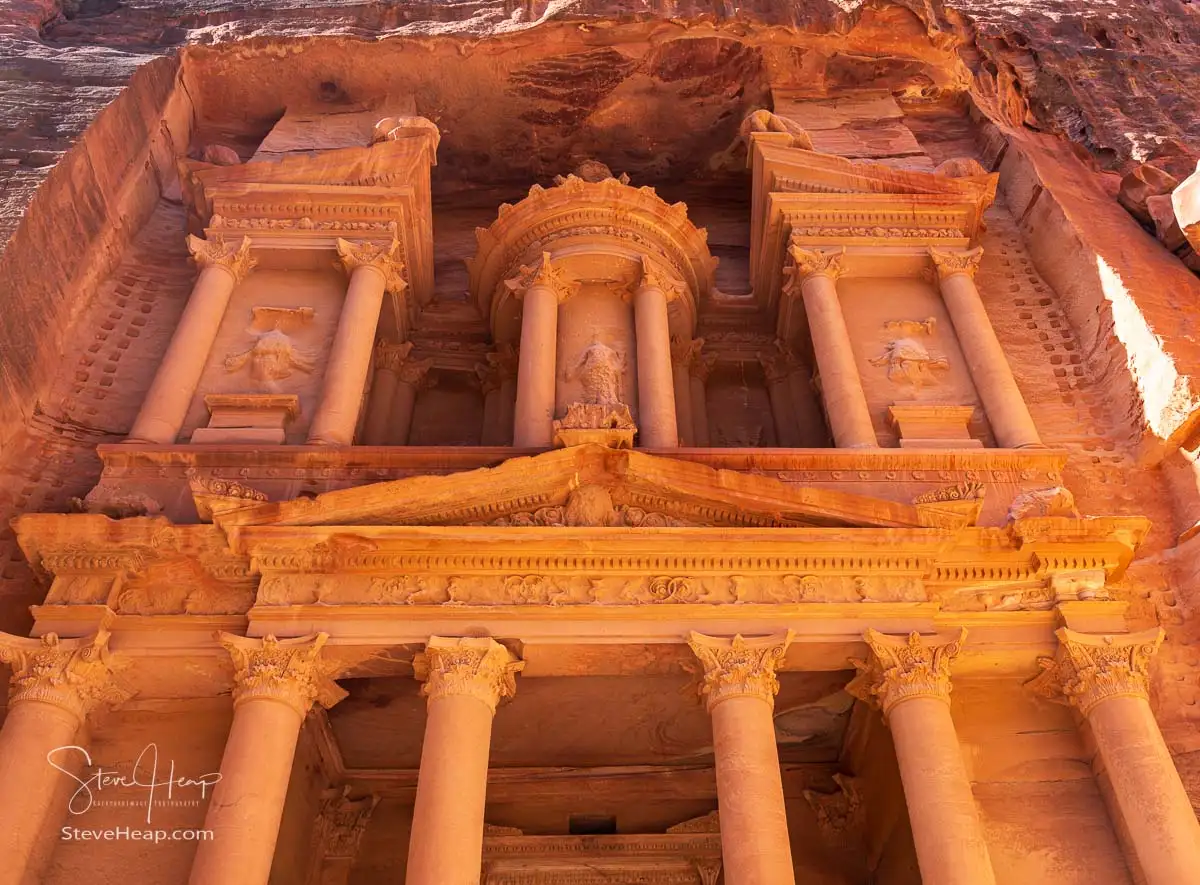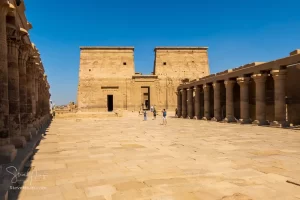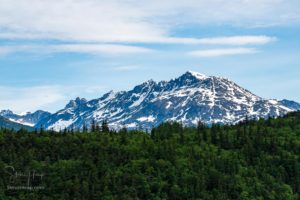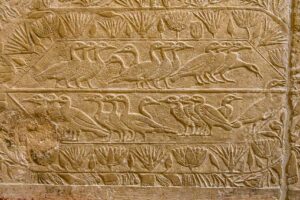In my usual approach of writing an overview of a cruise followed by more detailed day by day articles, I will start with an overview of the extension to Jordan following the Nile River cruise known as the Viking Pharaohs and Pyramids Cruise. You can find the article about the Nile portion of the cruise here.
Let me first start by saying that we found the Jordan extension to be just as fascinating as the trip through Egypt – different in a lot of ways, but still extremely interesting. Firstly, Jordan is a much different country – very stable, very organized with well-defined rules that are followed. No crazy driving and it generally felt very safe. Although I’m sure that people will take US dollars, there is much more of an expectation that you will use their currency, the Jordanian Dinar, which is itself stable and easy to obtain from ATMs (or before you travel). As far as I know, you can also convert any excess Dinars back to dollars, although we used pretty much all of the currency we changed. Remember that your guide, who is with you the entire time, is not a Viking employee and so there are no mandatory tips charged to your Viking account.
At the moment with the issues in the Middle East (or the Levant as the locals prefer to call it), tourism is way down and you can see the famous sights without the normal throngs of tourists. That is unfortunately pretty hard on the guides – ours only worked for one tour a month at the moment so his income has taken quite a hit.
Flying to Jordan
As usual, it is an early rise to leave the hotel in Cairo (which is close to the airport) to catch the flight to Amman. Remember as well that your luggage is going to be scanned for binoculars – two of our group had their luggage separately moved to the office and they had to explain what sort of binoculars they had. Both of them got to keep their equipment – we were told that less than 10x magnification was OK, although I think that isn’t a hard and fast rule. If it is confiscated, it is held at the airport for you to pick up when you arrive for your departure flight. My 400mm lens was deemed to be OK and no-one actually asked to look at it. The person meeting us to arrange the visas (which is just obtained when you arrive) handled the negotiations around the binoculars, although the rest of the group had to hang around while this took place.
Tour around Amman and drive to the Dead Sea
There is quite a lot of coach travel on this extension. Your guide will meet you on the coach and then he and the driver stay with you throughout the tour. We started with a drive around Amman to get a feel for the place – including the massive US Embassy. And we were seriously warned not to take any photos through the coach windows. If you are spotted doing that, the coach will be stopped and everyone’s phones searched for offending images. We had been given a packed breakfast when leaving the hotel although we lost one of them trying to navigate through the bag searches at Cairo airport. From what I recall, that was to last through lunch and our guide bought us some traditional cookies on the drive down to the Dead Sea. After stopping for photos by the “sea level” sign on the way to the Sea, we went on up an endlessly winding road to the Dead Sea Panorama Museum, a modern building and cafe/bar, to understand more about the Dead Sea and the area we were visiting. Great views from there and we were the only people around. Drinks and ice-creams are available, and they probably did food, although I don’t recall anyone buying any.
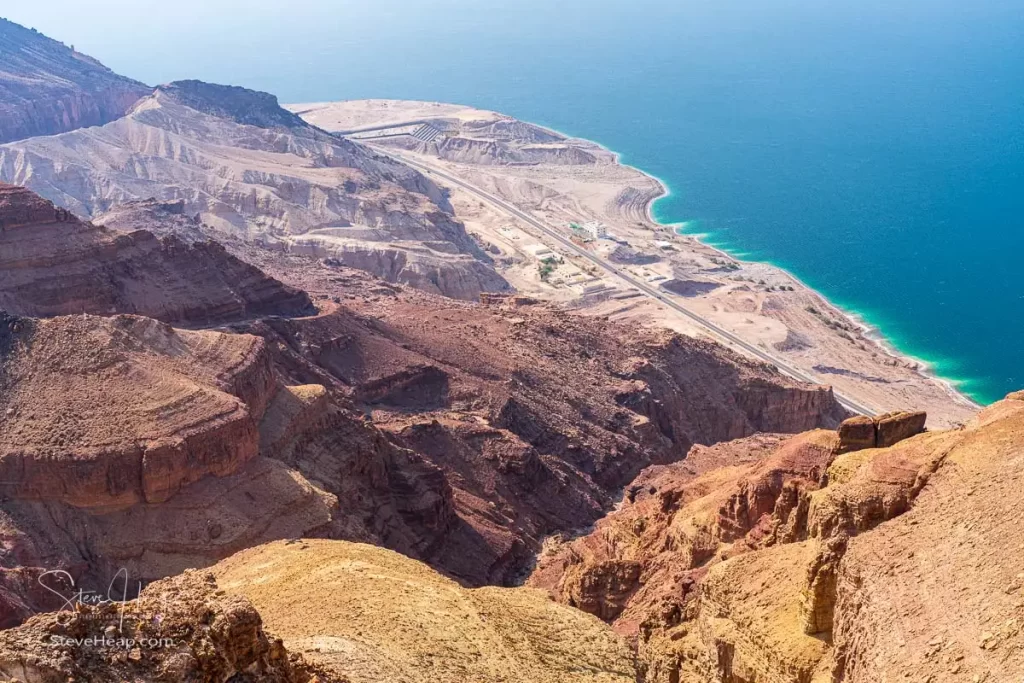
It was misty in the distance, and you could just about see the coast of Israel. Jerusalem is visible on clearer days. As you can see from the photo, the Dead Sea is shrinking year by year as the water entering it from the River Jordan is used for agriculture and other purposes before it ever reaches the sea. The coastline is moving further and further from the hotels built to access it and our hotel, the Movenpick, had steps and a road for the golf shuttles that were available (for free) to take you up the long walk back to rooms. The hotel was great though, well-appointed and with many facilities including swimming pools and the access to the sea.
The afternoon is at leisure, and most people made their way to try out the sea. We had some inexpensive water shoes from Amazon as it is somewhat rocky entering the water, but it is everything you expect it to be. Some people had books so they could lie back in the water and read, others applied the thick black very salty mud that is supposed to do wonders for your skin:
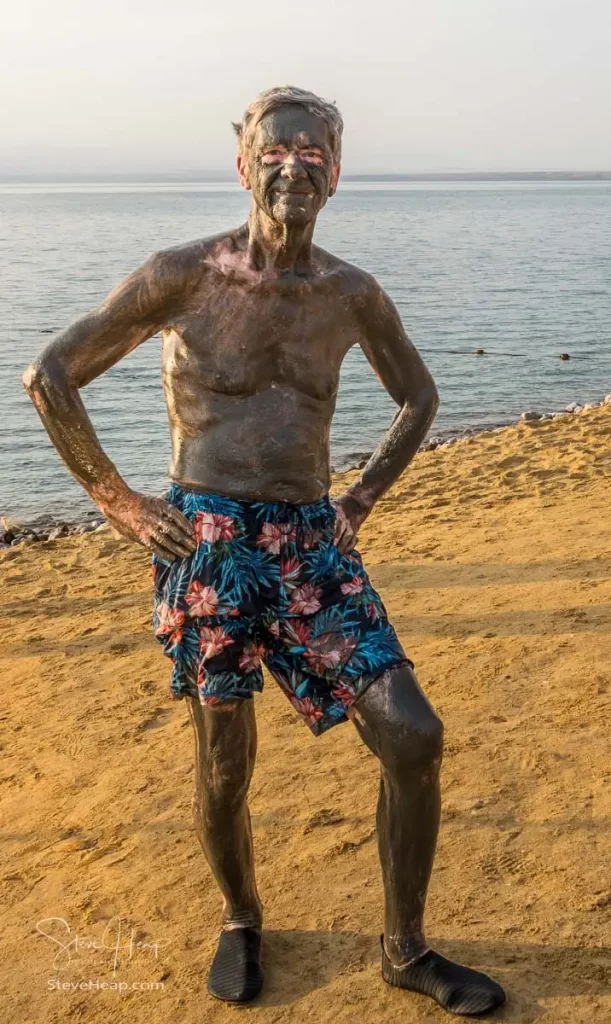
There are showers to clean up before you head back to your rooms, and it was certainly great fun to just float about in the water. There are lifeguards if you are uneasy about the adventure.
The sun sets over Israel, so you can get some pretty nice sunsets from the various terraces that make up the hotel grounds:
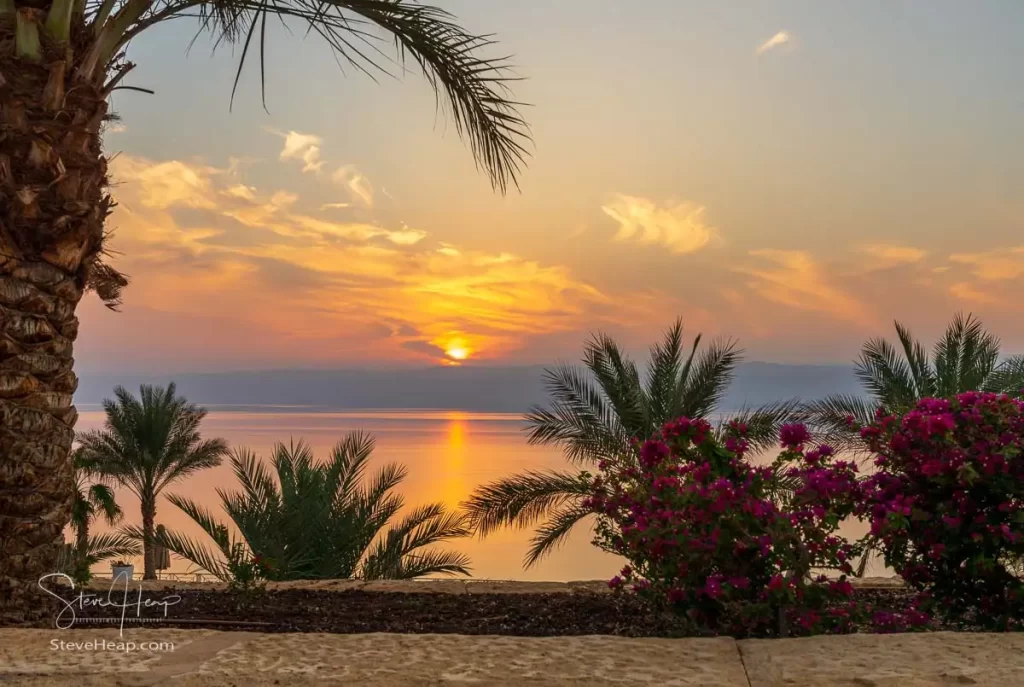
A buffet dinner was included, but in Jordan, all alcoholic drinks were an extra charge.
The full article describing this day at the Dead Sea can be found here.
The road to Petra
After breakfast, we were ready for our long drive to Petra. The full story can be found here. The drive is broken up though with a couple of visits. The first was to the Memorial Church of Moses on Mount Nebo. Traditionally thought to have been the burial place of Moses, it is an intriguing modern building that houses the ruins of much older churches and buildings and also some magnificently preserved and presented mosaic floors from the area. The first church on the site was in the 4th Century AD and was in use for about 1000 years before being abandoned. The remnants were eventually rediscovered in the mid-19th Century which kicked off the archeological work necessary to rescue the ruins. The modern enclosure was only completed in 2019.
Pope Paul visited in 2000AD and this sculpture commemorates that visit:
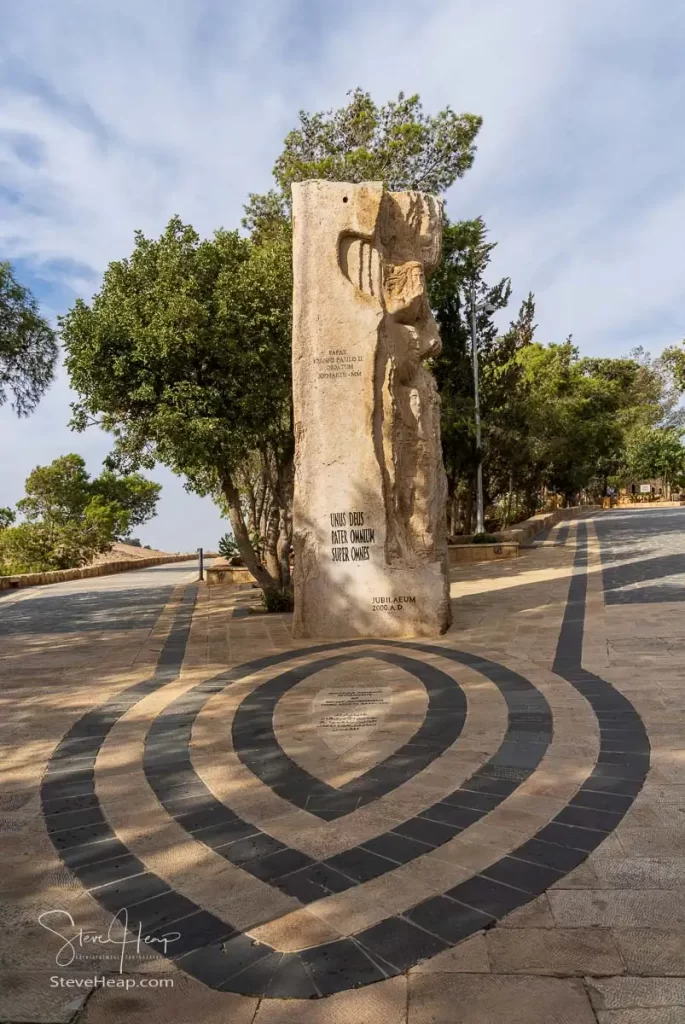
The mosaics are now under cover in the new church building and this next photo tries to show what they would look like from above. You can only stand at the side of them, so I’ve manipulated the images a bit to give an impression of the full thing:
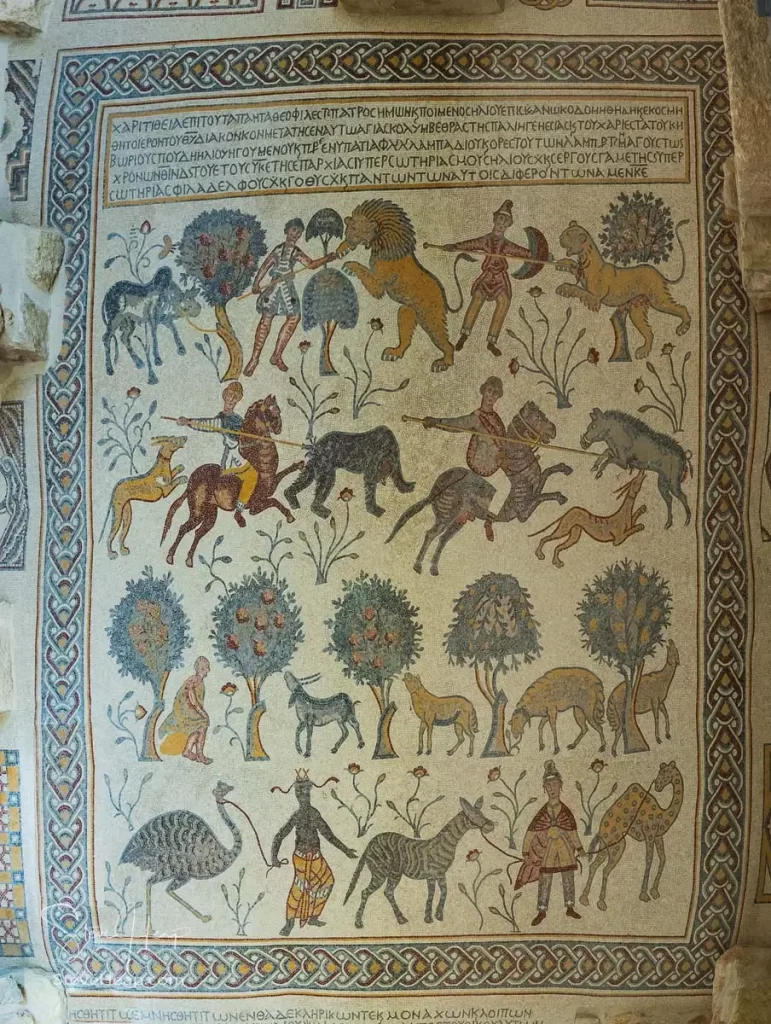
You get 360-degree views from here as well and can perhaps understand just how difficult it might have been to keep this church up and running in the past. Not much for miles around here!
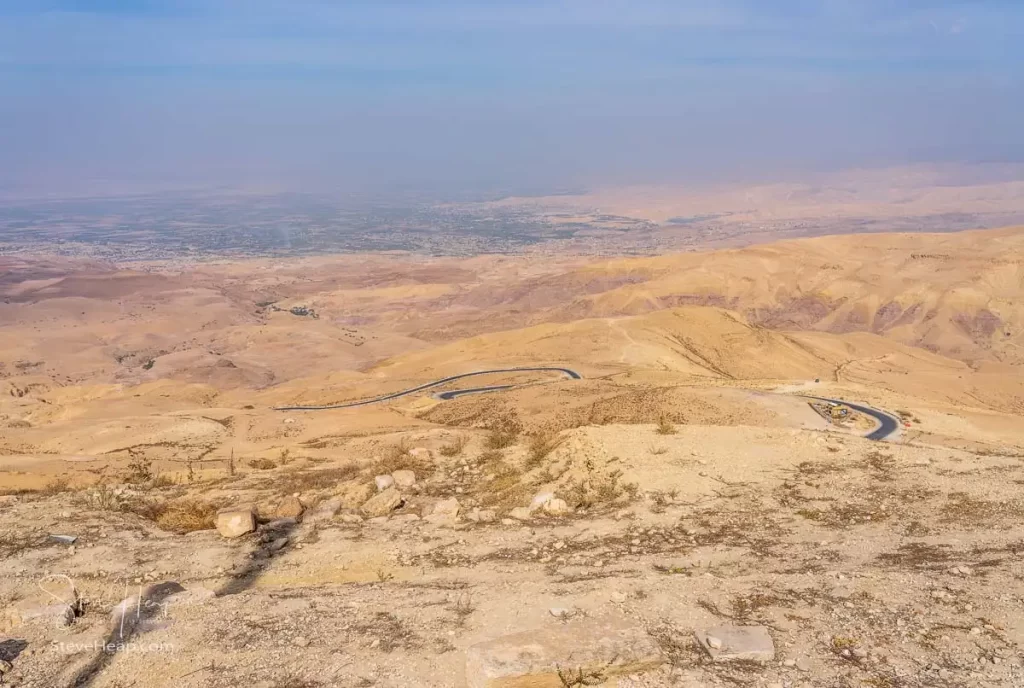
There are other museums here (plus the obligatory toilets) to visit before you return to the coach for the next leg of the journey, this time to a very famous mosaic in Madaba. This historically important mosaic is one of the only ones that gives a geographic view of the Biblical lands and gave archeologists valuable information about where other lost sights might be, including the place where Jesus was baptized by John. We were given an overview of the mosaic first in the small museum before visiting the church that houses it:
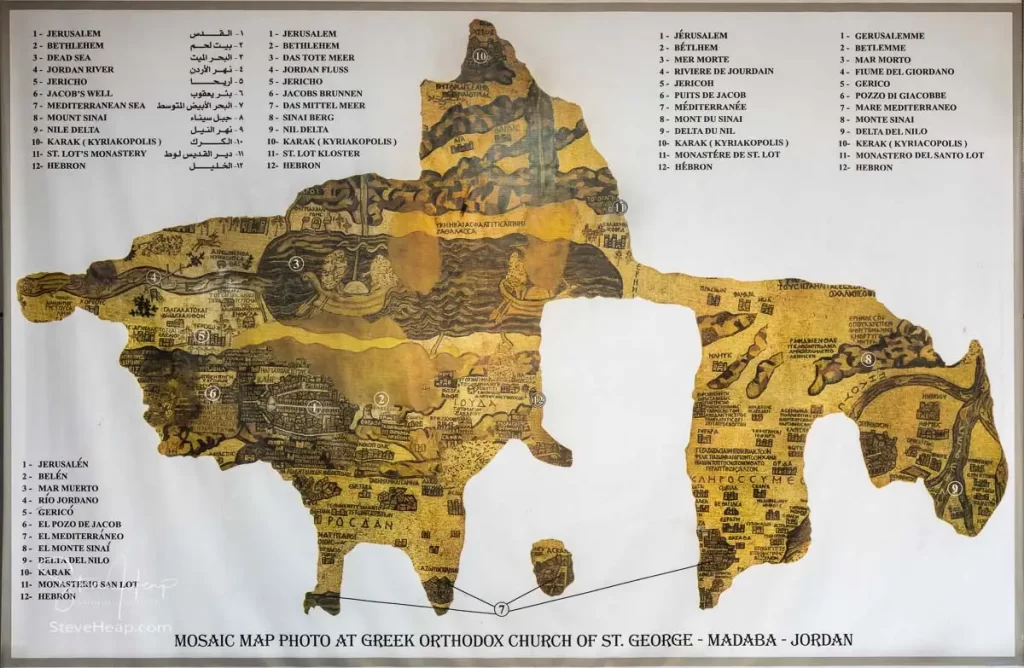
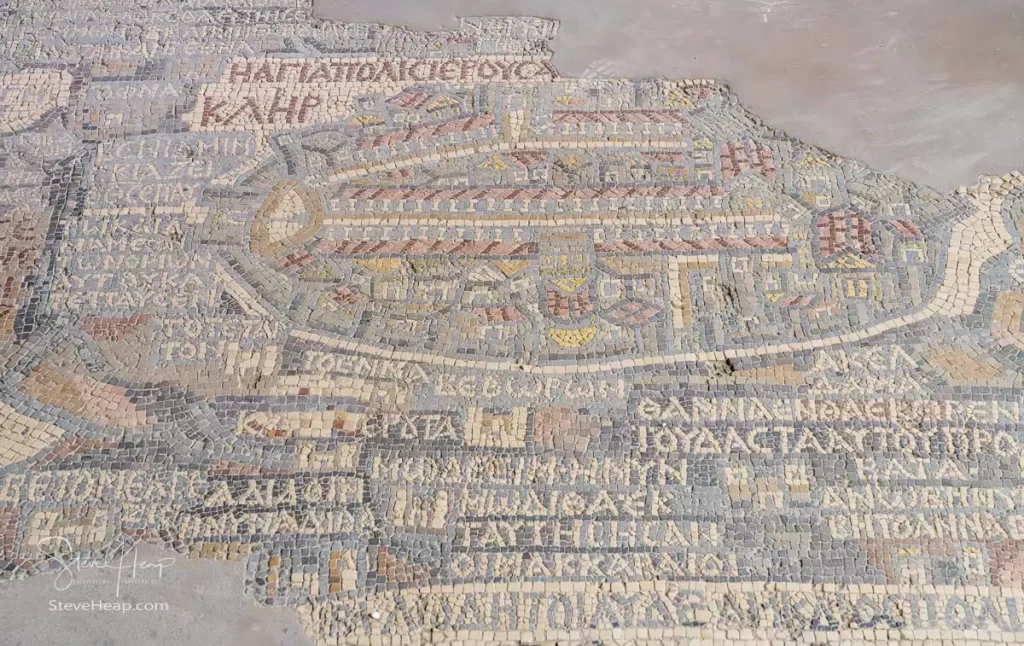
This visit was followed by lunch in a local restaurant, with a great choice of local beers if you are interested in that, and finally the journey ended at the hotel in Petra. Once again, a Movenpick that is immediately by the entrance and museum in Petra, which made for a very easy start the next day.
Petra and the stroll through the Capital City of the Nabateans
A stroll is definitely not a good description of this hike. Wear comfortable shoes, carry water, and be ready for the experience of your life. That day, I walked almost 10 miles and climbed the equivalent of 66 floors, although, to be fair, I did the optional climb to the Monastery which you find at the end of the main walk through the city.
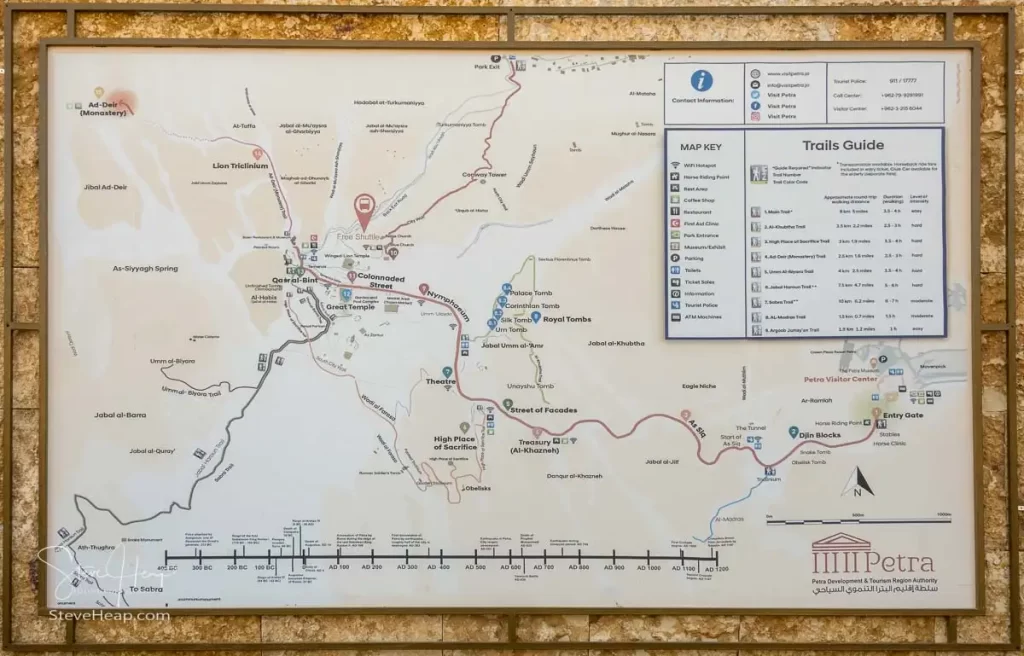
Most of the early part of the walk, in the As Siq, or tunnel, is in the shade, but most of the rest is in the open sun. In early November it was quite pleasant – maybe mid-70s or so, but it can get much hotter (and colder) in different times of the year. But to say the entrance to the city itself is impressive is to really understate it. The view at the end of the tunnel is magnificent:
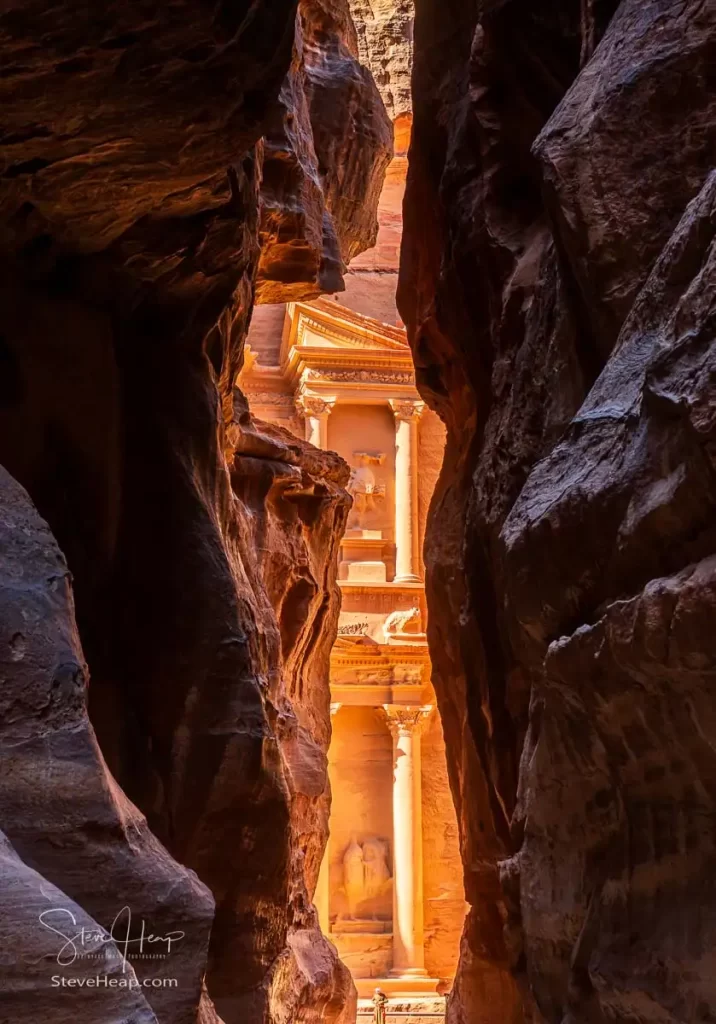
You can imagine what a sight it was for the camel trains that were making their way to the East back when the city was, in effect, a toll booth on the main trade routes. I will enjoy illustrating more of Petra when I write the full article about it but suffice to say that you do get a break in a tent/shop part way through, and then can either try one of the trails, or head back to the shuttle that takes you back to town and the hotel. There are also donkey rides offered at many points, including up to the Monastery and also from the end of the trail back to the shuttle bus. I did the Monastery trail, which is where the 66 flights of stairs came in, but that was spectacular both from the building up there, but also the views across the hills to the desert. It takes about 45 minutes to climb to the Monastery and the way is firm, but the steps are worn in places. Not slippery though, which helps a lot.
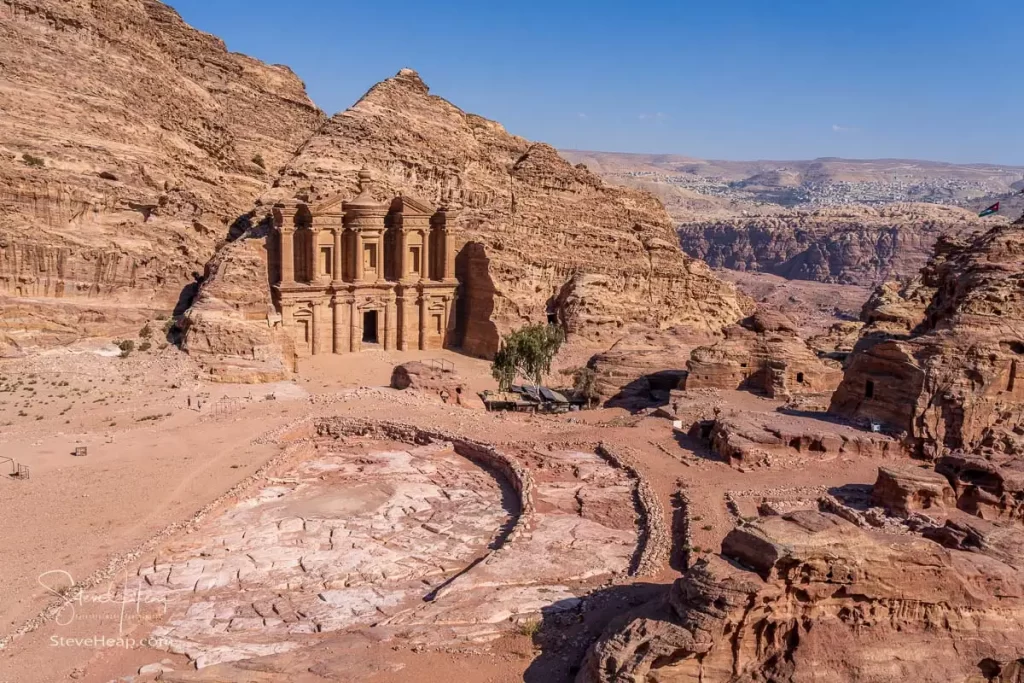
The donkeys that walk up and down this steep trail do seem well trained though – they can do it on their own!
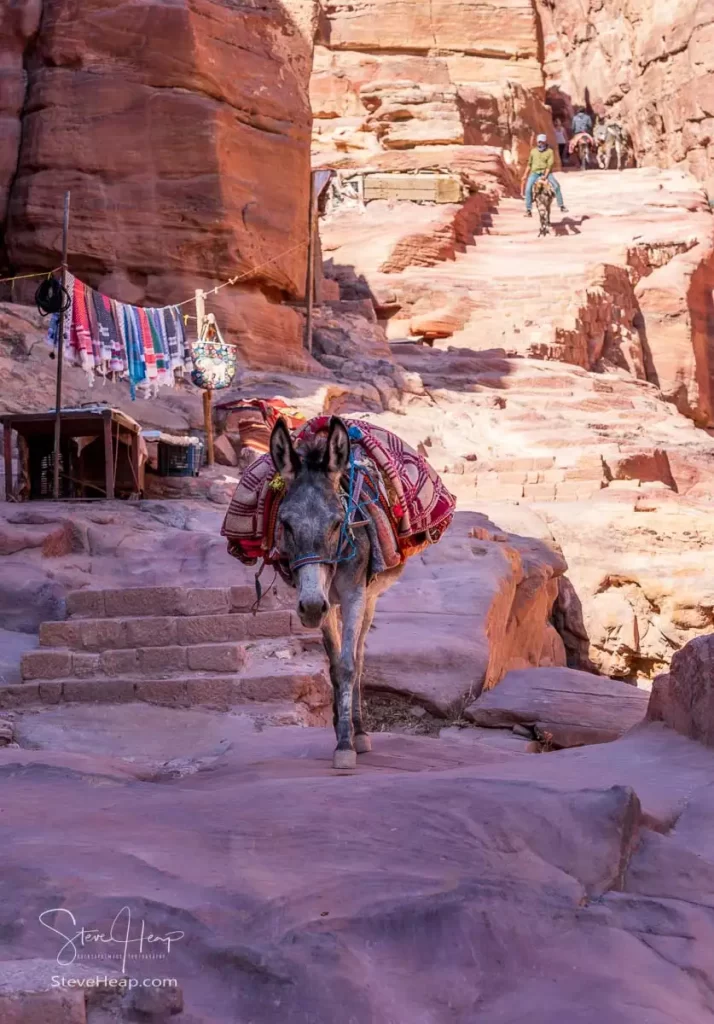
This brings me to my only peeve of the day – the walk to the shuttle relatively quickly comes upon a fantastic shuttle stop with seats, shades and plenty of room for the shuttles to turn around. But they are not there – they are about half a mile further up the road. They then fill each shuttle in turn, which can take 20 minutes when the tourists are not visiting, and instead of taking you back to town, you have to visit a newly built shopping village and are forced to get out for 20 minutes and walk through the village before the same shuttle will pick you up again. To say the passengers are annoyed by this is an understatement. Of course, no-one bought anything on principle, and we just waited to get back on the bus to get to the hotel. Tips to the shuttle driver – zero.
Beers in the hotel bar – fantastic and just what the doctor ordered. The evening buffet is not included, and some went to a local restaurant inside caves just above the entrance to Petra and reported back very favorably. Not surprisingly it is called the Cave Bar! We were just too tired, though.
Jerash and Amman
The next morning, we were on the road again. This time to journey back north to the city of Jerash, itself north of the capital Amman. Inhabited since the Bronze Age, it’s known for the ruins of the walled Greco-Roman settlement of Gerasa just outside the modern city. We did take breaks along the way – usually in a large store with time to buy some more gifts to take home, but we arrived in Jerash before lunch and voted to see the Roman city and then have lunch. This is a magnificently preserved set of ruins, with a lot of walking, once again, as we learned about the history of the place. You enter the city through a massive gate:
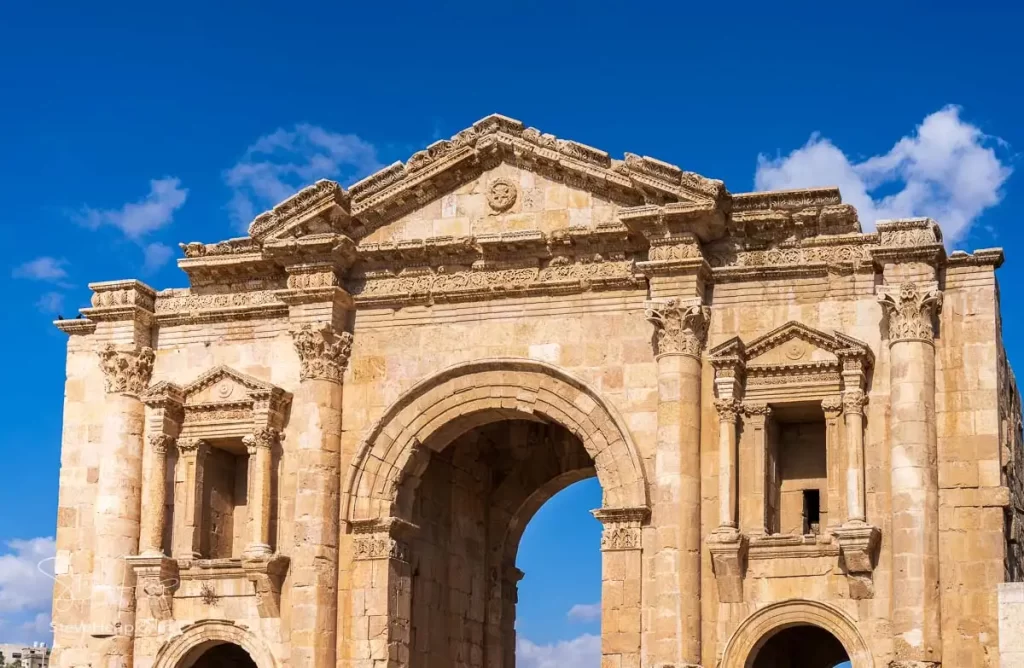
The Oval Plaza is a well-preserved feature to connect the main street of the city with the Sanctuary of Zeus and has this unique oval shape. It was constructed around the 2nd Century AD and the paving came a couple of centuries later. It is fascinating to think that these stones that we all walked also trodden by all the people almost 1800 years ago. Here is our guide explaining something about the way the stones were laid (I think!)

The smaller of the two coliseums in the city!
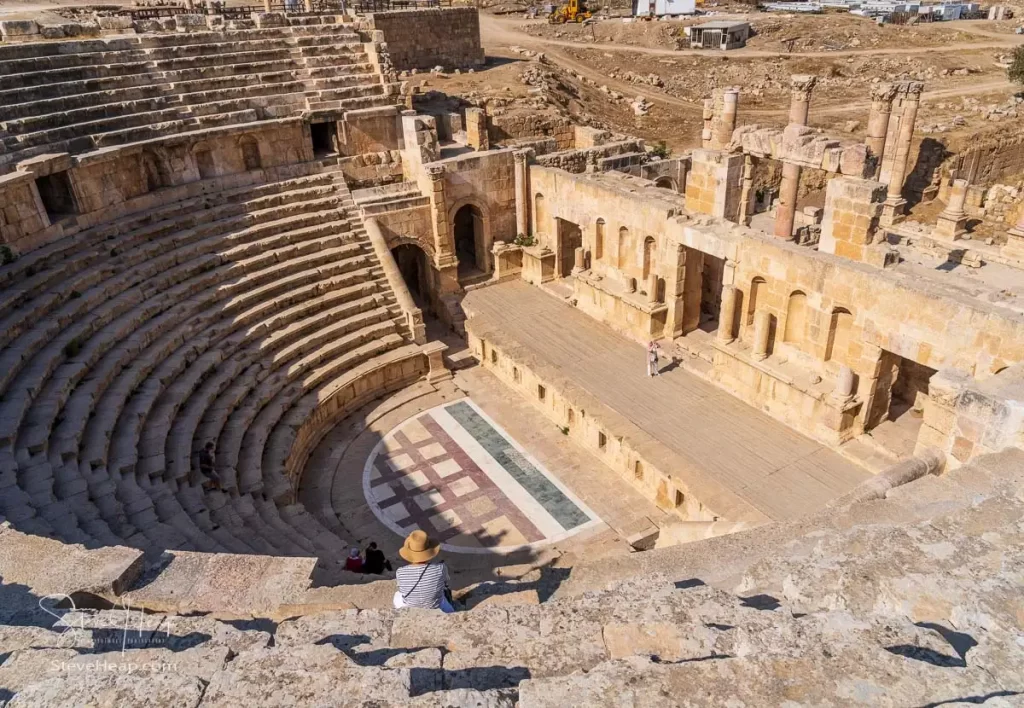
It’s great to be able to wander among the ruins to capture those unusual shots – this was a favorite place for selfies, but I thought the shapes were intriguing.
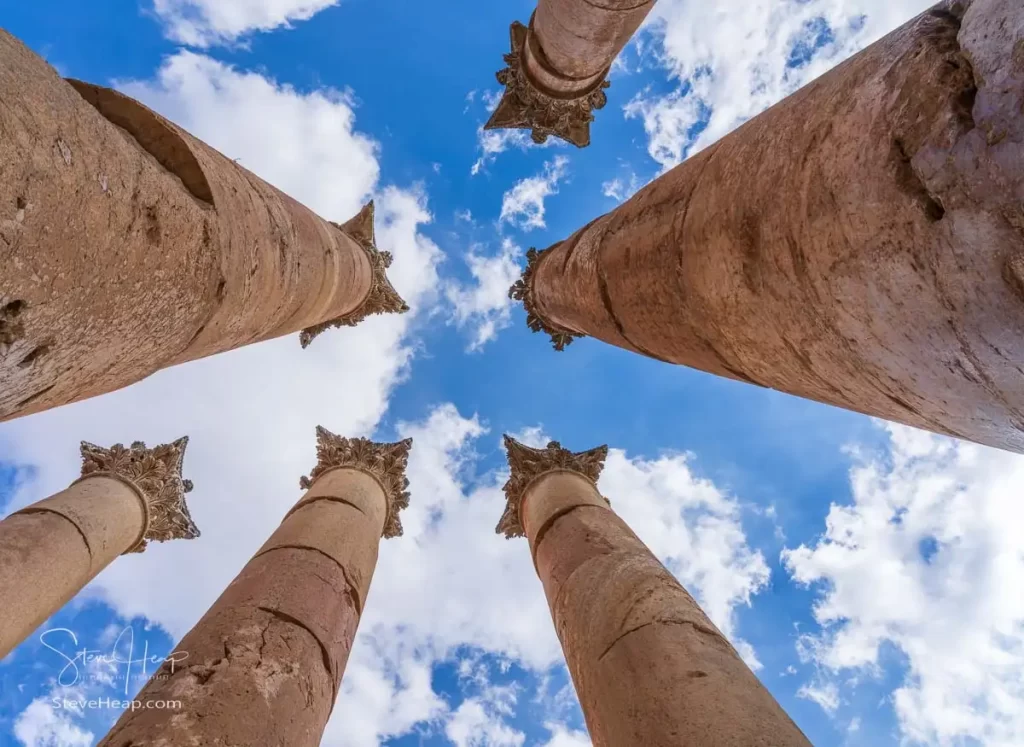
After this visit to the ruins, we drove to a great local restaurant for lunch and finally made our way into Amman to the hotel for the final night of the extension. Another great hotel, but many people either had to leave in the middle of the night, or very early the next morning. We had booked a flight that gave us a full day in Amman and left in the evening of the following day, so we booked two nights in the Hilton (another great hotel in Amman) and so said our goodbyes to the group and our guide Eyas Srour when we arrived. Eyas had been a great host, giving us the many facts about the places we visited, but also filling in many gaps about the world’s religions and especially the various religions in the Levant as we were traveling about.
In Amman we visited the Coliseum there (via Uber) and also the Jordan Museum. There are more things to see, but we were happy to relax a little by this stage and stroll through the very upmarket mall by the hotel and even got to see a fire and rescue exercise around an office building by the mall to round off our trip:
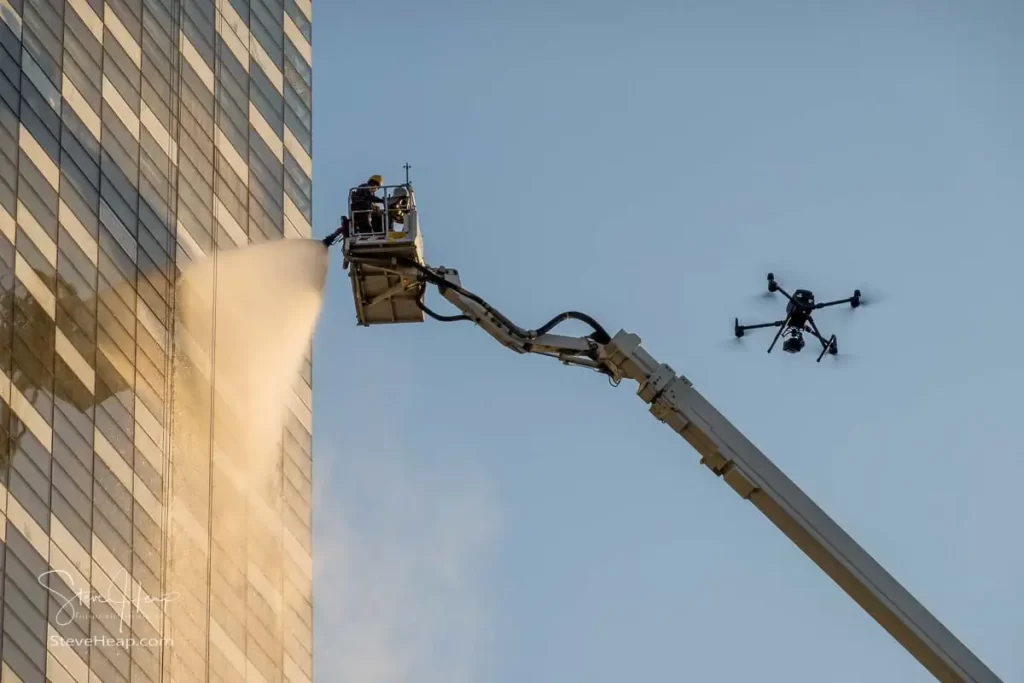
Finally, we made our way to the airport (via Uber again for about $20) and flew to Dubai then on United’s flight to Newark overnight and finally on to Texas. A long night and day, but everything went smoothly!
More articles to come as I get the opportunity to process my many, many photographs of this memorable trip.
